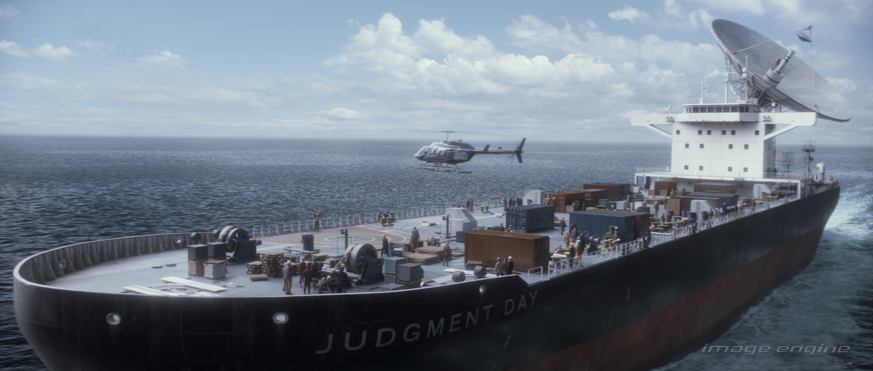3 Body Problem Case Study
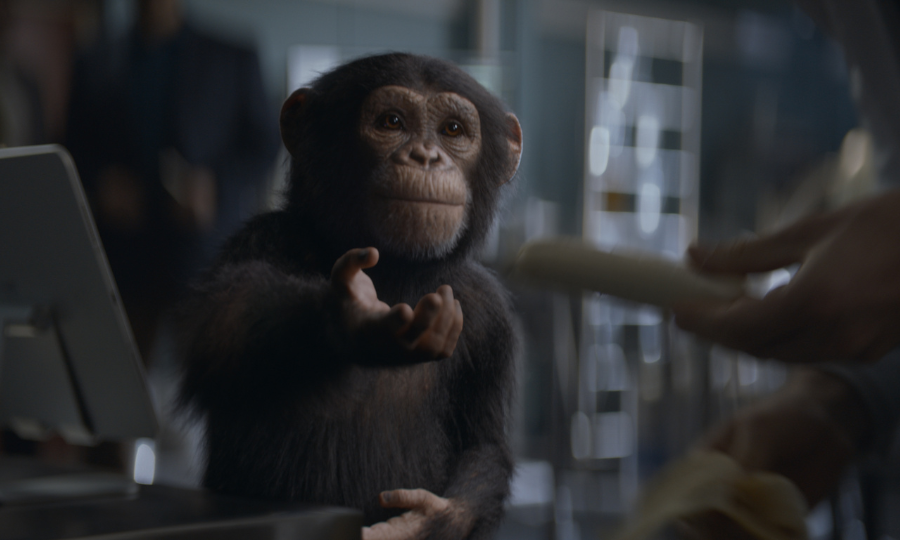
Case Study
From Game of Thrones creators David Benioff & D.B. Weiss, 3 Body Problem is Netflix's epic adaptation of the bestselling novels of the same name. Pushing the boundaries of visual effects, our team at Image Engine was thrilled to contribute 137 shots to this thrilling new mystery.
View portfolio page Watch our breakdown reelFrom Game of Thrones creators David Benioff & D.B. Weiss, 3 Body Problem is an epic adaptation of Cixin Liu’s bestselling sci-fi novel series of the same name. Set against the backdrop of China’s Cultural Revolution, a secret military project sends signals into space to establish contact with aliens. An alien civilization on the brink of destruction captures the signal and plans to invade Earth. Meanwhile, on Earth, different camps start forming, planning to either welcome the superior beings and help them take over a world seen as corrupt, or to fight against the invasion. The result is a science fiction masterpiece of enormous scope and vision.
Pushing the boundaries of visual effects, our team at Image Engine was thrilled to contribute 137 shots to Netflix’s sci-fi drama, 3 Body Problem. This case study delves into the intricate details and innovative techniques we used to bring the show’s many interesting characters, locations, and plotlines. to life, showcasing the meticulous craftsmanship behind our VFX creations.
Read the Q&A below featuring our crew:
- Thomas Schelesny, Visual Effects Supervisor
- Matt Yeoman, Compositing Supervisor
- Richard Spriggs, Animation Supervisor
- Barry Poon, Head of Assets
- Rob Richardson, Head of FX
- Evan Zazula, FX TD
Neutrino Observatory
In the first episode, we see scientist Dr. Vera Ye enter the Cherenkov tank, walk out onto a platform and jump into a shallow pool of water below. A Cherenkov tank is a particle detector used to observe, measure, and identify particles, including, in this case, neutrinos, a common particle that comes largely from the sun.
Can you please discuss the work that went into the Neutrino Observatory scene? What needed to be achieved for this shot?
Matt: Vera’s plate element of her walking along a suspended walkway needed to be integrated into the Neutrino Observatory, which was a full CG environment render. The main objective of this shot was to create a sense of scale for her very unique and mysterious surroundings. In the reflection of the spherical neutrino sensors, you can get a glimpse of Vera walking and the water that is so far below.

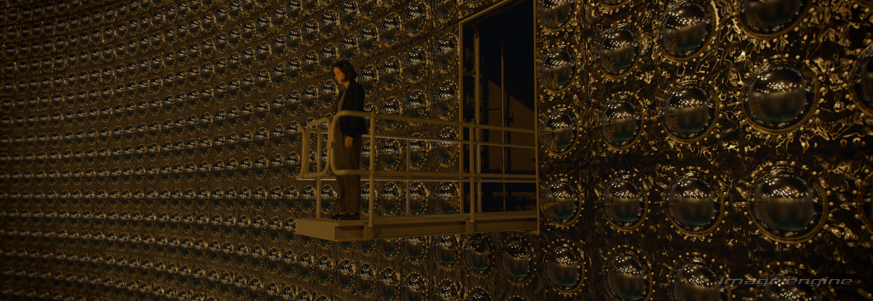
Judgment Day
Forebodingly named Judgement Day, this large oil tanker is the floating HQ of Mike Evans. The ship has been redesigned as a floating city to house his Earth-Trisolaris Organization (ETO) and await the arrival of the San-Ti aliens.
Can you tell us about the asset creation of the Judgement Day? What were the challenges?
Matt: In order to have the digital Judgement Day renders integrated with the live-action footage, a 3D asset needed to be created of the ship with all of the objects that are visible on the deck. In this case, you can see some container offices, bleachers and even a basketball court that is surrounded by a chain link fence, to name a few. All of these objects needed to line up perfectly with the on-set photography and the match move needed to be very precise. This was needed because the CG ship render was used to generate ID mattes that were then used to isolate the needed areas of the live-action footage.
To ensure everything felt as realistic and believable as possible, we closely matched to reference photography of container ships travelling in the ocean. Adding correct depth cueing and having the light appear to interact with the marine haze helped sell the shots.
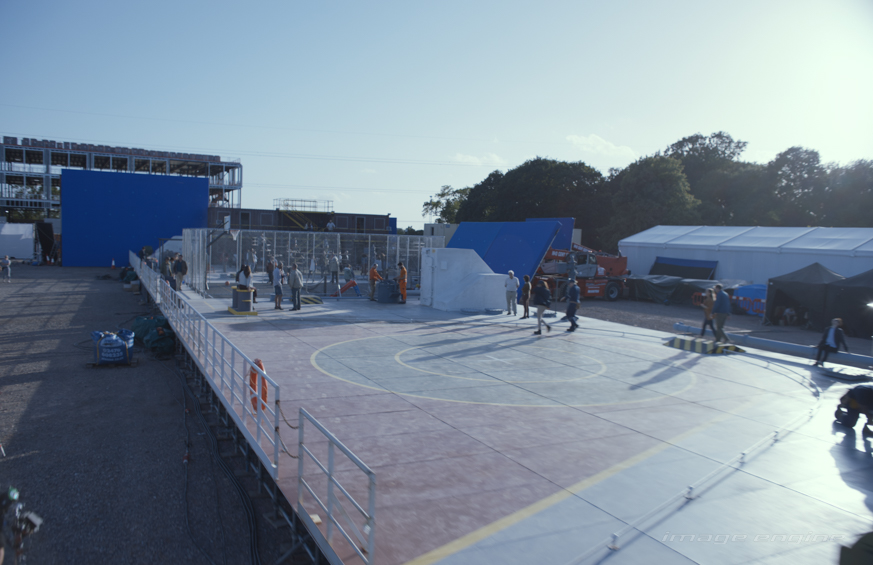
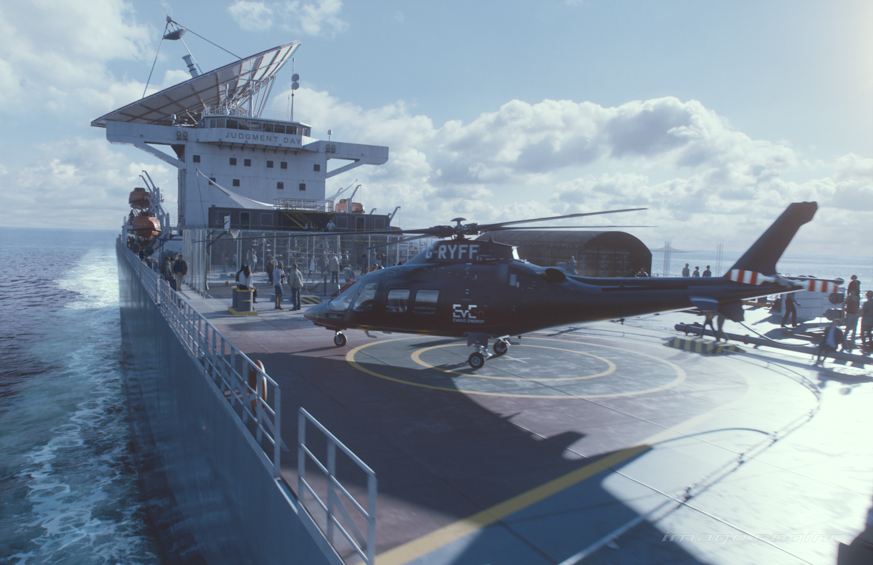
Frozen Chimpanzee
Since the interstellar journey to the planet Trisolaris would take a staggering 200 years, a team of scientists in 3 Body Problem devised a cryogenic hibernation as the solution. A chimpanzee named Kolya became the test subject, enduring over a month in a frozen state. As the research team anxiously observes, Kolya emerges from the hibernation capsule, performs a few cognitive assessments, and promptly vomits up a banana in a display of post-hibernation nausea.
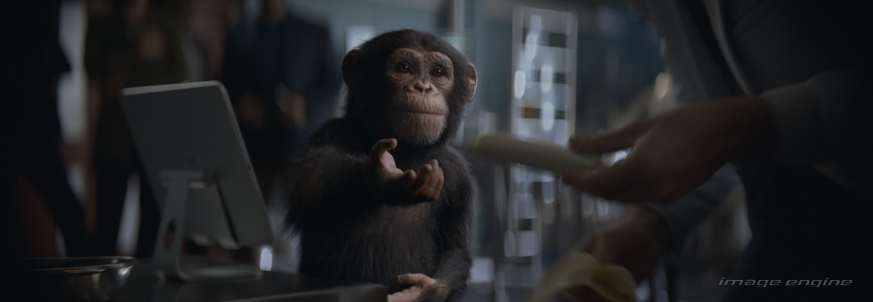
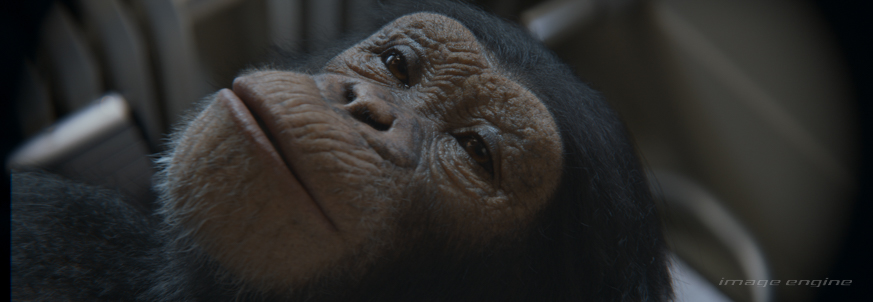
How did you build this asset? Can you discuss the subtle details, texturing, musculature, and skeleton of the chimp?
Richard: Our team recreated every aspect of the chimpanzee’s anatomy, meticulously sculpting the intricate musculature and capturing the nuanced texture of its fur and skin. We ensured that each muscle, bone, and facial expression found its faithful representation within our captivating 3D digital character. Extensive research uncovered that the most vivid facial expressions in chimpanzees manifest during activities such as eating, necessitating a broad spectrum of facial shapes within our rig. The process involved iterative efforts among rigging, modelling, and animation teams to ensure not only anatomical accuracy but also the precise movements of facial expressions. This meticulous approach guarantees that our chimpanzee moves with unparalleled authenticity, mirroring the natural movements of its real-life counterpart.
The success of our work stands as a testament to the versatility and realism of our creation. What sets our creation apart is not merely its aesthetic fidelity, but its unparalleled authenticity in movement and expression. The chimp’s distinctive personality shone through, forging a profound emotional connection with viewers, making the animated character an integral and engaging part of the story.
How did Image Engine’s past work on creatures feed into making this chimp character as believable as possible?
Barry: We are always refining our creature-building process, continuing to learn from each new creature we build. Tools and techniques are constantly evolving but many of the main steps we use continue to be the same. Using applicable references and having our artists work closely together are examples of steps that we have learned are extremely important. On-set references such as scans and properly calibrated images from a scanning photo booth can be essential in helping us achieve good results quickly. Unfortunately for our chimp build, we never had a specific chimp to match to. This made our build more challenging and our reference gathering and experience working on other creatures that much more valuable.
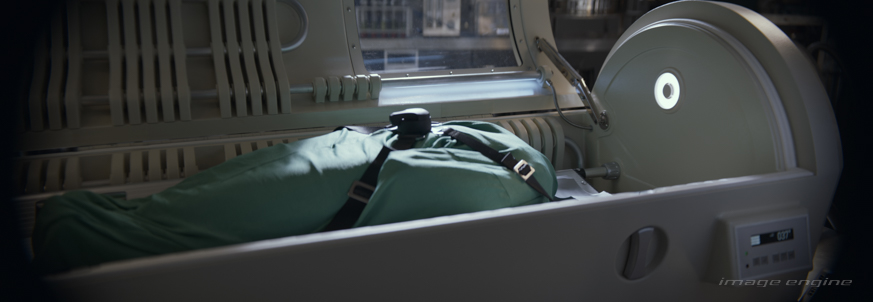
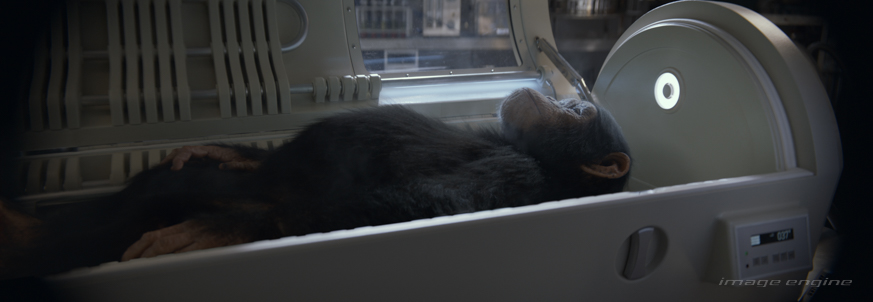
How did the animation team approach the animation of the ape?
Richard: The chimp was cryogenically frozen and brought to life within a short period of time. The chimp’s performance needed to reflect what it had just gone through. It needed to feel drowsy, tired, and being frozen for so long, hungry too! Relying solely on keyframed animation without motion capture, our dedicated team of talented animators breathed life into the digital model. Their expertise allowed them to infuse the chimp with subtle emotions and expressions, creating a captivating and realistic animated character that resonates deeply with the audience.
Can you discuss the challenges when the chimp steps out of the cryo chamber?
Richard: We really wanted to feel like it was a chimp performing these actions, not a human. It was important to make the chimp interacting with the scientist believable, a lot of that came from the performance. We didn’t want the performance to feel one-dimensional and simply perform each action.
We needed the chimp to go through different emotions and react to the situation. It goes from being frozen to hungry, slightly annoyed at not getting the banana, satisfied once it gets it, and then ultimately feeling sick over it. It’s a lot of different emotions that needed to be captured in a short amount of time. The final result demonstrates a character that feels like it’s actually thinking and living.
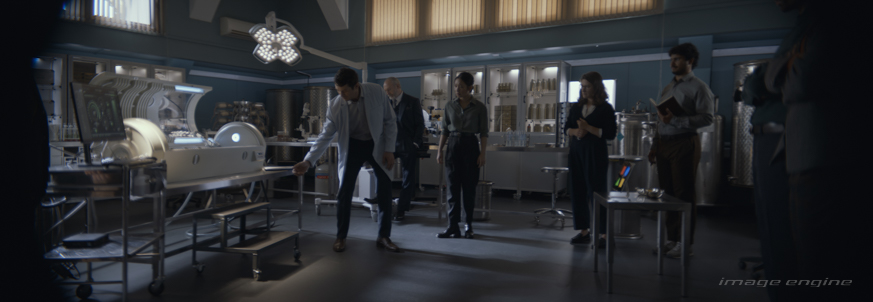
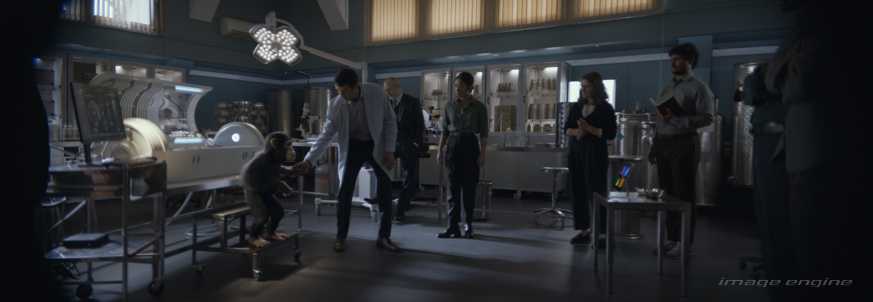
How did you go about creating the chimp’s vomit?
Rob: The base of the vomit was a fluid simulation and we were able to control how the liquid moved. But it wasn’t just one big blob – we gave different areas within the simulation varying levels of viscosity and some sections were extremely dense.
The viscosity actually played a big role in how the fluid was shaded. Shading tells the computer how light interacts with the object on the screen, things like transparency and colour. So, the thicker parts of the simulation were shaded differently to make them look a bit more solid, almost like melted banana chunks. Then, to really sell the effect, we added smaller pieces of banana debris throughout the scene. These were also affected by the fluid simulation, so they moved realistically within the vomit.
How did you approach finding references for the vomit?
Evan: We actually started with videos of gorillas throwing up, which seemed like the obvious choice. But footage of cat vomit ended up being more helpful. Cat vomit often has those isolated chunks of food, which is exactly what we were going for with the partially digested banana look. Finding good vomit reference footage was a challenge since the algorithms probably aren’t promoting those kinds of videos!
How did you end up with chimp vomit duty?
Evan: Well, part of it was definitely wanting to work on 3 Body Problem in general. But honestly, it also just sounded like a hilarious task so I volunteered right away! I’m pretty proud to have “chimp vomit” as a credit on my demo reel.
Conclusion
We are thrilled to have contributed to Netflix’s new ambitious sci-fi drama, 3 Body Problem. Our meticulous attention to detail, from replicating the vastness of the Neutrino Observatory to breathing life into a photoreal chimpanzee animation, resulted in a mind-bending world of remarkable visuals.
The new series has achieved remarkable success, ranking No. 1 among streaming titles for two consecutive weeks, with a staggering 1.79 billion minutes of viewing recorded for March 25-31, 2024. This achievement speaks volumes about the captivating storytelling and immersive world we helped create. This project was a collaborative triumph, showcasing the exceptional talent and creativity of our entire team.


